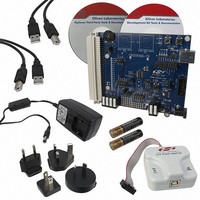C8051F996DK Silicon Laboratories Inc, C8051F996DK Datasheet - Page 156

C8051F996DK
Manufacturer Part Number
C8051F996DK
Description
KIT DEV FOR C8051F996
Manufacturer
Silicon Laboratories Inc
Type
MCUr
Datasheets
1.C8051F996DK.pdf
(24 pages)
2.C8051F996DK.pdf
(2 pages)
3.C8051F996DK.pdf
(4 pages)
4.C8051F996DK.pdf
(322 pages)
Specifications of C8051F996DK
Contents
Board, Batteries, Cables, CDs, Debug Adapter, Documentation, Power Adapter
Processor To Be Evaluated
C8051F996
Processor Series
C8051F98x
Interface Type
USB
Operating Supply Voltage
3 V
Lead Free Status / RoHS Status
Lead free / RoHS Compliant
For Use With/related Products
C8051F996
Lead Free Status / Rohs Status
Lead free / RoHS Compliant
Other names
336-1963
- C8051F996DK PDF datasheet
- C8051F996DK PDF datasheet #2
- C8051F996DK PDF datasheet #3
- C8051F996DK PDF datasheet #4
- Current page: 156 of 322
- Download datasheet (3Mb)
C8051F99x-C8051F98x
14.5.2. PSWE Maintenance
1. Reduce the number of places in code where the PSWE bit (b0 in PSCTL) is set to a 1. There should be
2. Minimize the number of variable accesses while PSWE is set to a 1. Handle pointer address updates
3. Disable interrupts prior to setting PSWE to a 1 and leave them disabled until after PSWE has been
4. Make certain that the Flash write and erase pointer variables are not located in XRAM. See your
5. Add address bounds checking to the routines that write or erase Flash memory to ensure that a routine
14.5.3. System Clock
1. If operating from an external crystal, be advised that crystal performance is susceptible to electrical
2. If operating from the external oscillator, switch to the internal oscillator during Flash write or erase
Additional Flash recommendations and example code can be found in “AN201: Writing to Flash from Firm-
ware", available from the Silicon Laboratories web site.
156
exactly one routine in code that sets PSWE to a 1 to write Flash bytes and one routine in code that sets
both PSWE and PSEE both to a 1 to erase Flash pages.
and loop maintenance outside the "PSWE = 1;... PSWE = 0;" area. Code examples showing this can be
found in :AN201: "Writing to Flash from Firmware", available from the Silicon Laboratories website.
reset to 0. Any interrupts posted during the Flash write or erase operation will be serviced in priority
order after the Flash operation has been completed and interrupts have been re-enabled by software.
compiler documentation for instructions regarding how to explicitly locate variables in different memory
areas.
called with an illegal address does not result in modification of the Flash.
interference and is sensitive to layout and to changes in temperature. If the system is operating in an
electrically noisy environment, use the internal oscillator or use an external CMOS clock.
operations. The external oscillator can continue to run, and the CPU can switch back to the external
oscillator after the Flash operation has completed.
Rev. 1.0
Related parts for C8051F996DK
Image
Part Number
Description
Manufacturer
Datasheet
Request
R
Part Number:
Description:
SMD/C°/SINGLE-ENDED OUTPUT SILICON OSCILLATOR
Manufacturer:
Silicon Laboratories Inc
Part Number:
Description:
Manufacturer:
Silicon Laboratories Inc
Datasheet:
Part Number:
Description:
N/A N/A/SI4010 AES KEYFOB DEMO WITH LCD RX
Manufacturer:
Silicon Laboratories Inc
Datasheet:
Part Number:
Description:
N/A N/A/SI4010 SIMPLIFIED KEY FOB DEMO WITH LED RX
Manufacturer:
Silicon Laboratories Inc
Datasheet:
Part Number:
Description:
N/A/-40 TO 85 OC/EZLINK MODULE; F930/4432 HIGH BAND (REV E/B1)
Manufacturer:
Silicon Laboratories Inc
Part Number:
Description:
EZLink Module; F930/4432 Low Band (rev e/B1)
Manufacturer:
Silicon Laboratories Inc
Part Number:
Description:
I°/4460 10 DBM RADIO TEST CARD 434 MHZ
Manufacturer:
Silicon Laboratories Inc
Part Number:
Description:
I°/4461 14 DBM RADIO TEST CARD 868 MHZ
Manufacturer:
Silicon Laboratories Inc
Part Number:
Description:
I°/4463 20 DBM RFSWITCH RADIO TEST CARD 460 MHZ
Manufacturer:
Silicon Laboratories Inc
Part Number:
Description:
I°/4463 20 DBM RADIO TEST CARD 868 MHZ
Manufacturer:
Silicon Laboratories Inc
Part Number:
Description:
I°/4463 27 DBM RADIO TEST CARD 868 MHZ
Manufacturer:
Silicon Laboratories Inc
Part Number:
Description:
I°/4463 SKYWORKS 30 DBM RADIO TEST CARD 915 MHZ
Manufacturer:
Silicon Laboratories Inc
Part Number:
Description:
N/A N/A/-40 TO 85 OC/4463 RFMD 30 DBM RADIO TEST CARD 915 MHZ
Manufacturer:
Silicon Laboratories Inc
Part Number:
Description:
I°/4463 20 DBM RADIO TEST CARD 169 MHZ
Manufacturer:
Silicon Laboratories Inc










